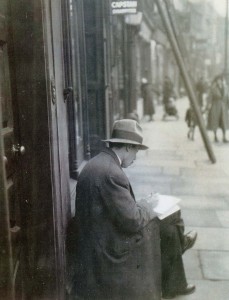New Spindler artwork at Harlow Carr keeps alive 80 year tradition

In 1936 Frederick was a passenger on the maiden voyage of the Queen Mary, and he must have been thrilled that the luxury liner also had an extensive collection of marquetry. He had these pictures recreated in the Belmont Room at Bettys York with the large mural depicting ducks flying over a lake.
Nearly 80 years on, the relationship between Bettys and the Spindler family is as strong as ever. They continue to create commissioned artwork for our Café Tea Rooms and the latest addition to our collection can be found at Bettys Harlow Carr. Entitled ‘Herbes Folles’, which means ‘wild grass’, the design was specially chosen to complement the gardens of Harlow Carr. It has no frame so as to create a light and airy feel – as if the grass is being blown by a light breeze.
Our collection
This latest acquisition brings our Spindler collection to 70 pieces. They are located in our York, Ilkley, Harlow Carr and Harrogate Café Tea Rooms, and in our Group Head Office. As far as we are aware, the Spindler Gallery in our Harrogate Café Tea Rooms houses the largest collection of Spindler works anywhere in the world.
The largest marquetry picture ever made in the Spindler studio was produced by Jean Charles Spindler in 1979, Bettys’ Diamond Jubilee year. It can be seen at our Café Tea Rooms in Ilkley and depicts a medieval hunt.
The Spindler Family
 Charles Spindler was born in 1865 in Alsace. He trained as a painter and was an accomplished water colourist, but was drawn to the craft, natural forms and flowing shapes of marquetry. For him the types of wood, their individual colouring and grain and their combination together was of primary importance, and he collected natural unstained veneers from around the world to create his ‘paintings in wood’.
Charles Spindler was born in 1865 in Alsace. He trained as a painter and was an accomplished water colourist, but was drawn to the craft, natural forms and flowing shapes of marquetry. For him the types of wood, their individual colouring and grain and their combination together was of primary importance, and he collected natural unstained veneers from around the world to create his ‘paintings in wood’.
How a marquetry picture is made
Spindler marquetry pictures are made by fitting various pieces of wood together in a thin sheet, which are then glued like a veneer to the surface of the panel. The pattern is cut by tightly fastening together two or more sheets of wood with a sheet of paper on top marked out with the design. A fine fret saw is used to cut along the lines of the design, after which the parts cut out of the top sheet can be exactly fitted into the lower sheet.
The Spindler studio today
The Spindler Studio is still thriving to this day, carrying on the family tradition. The artistic styles of Charles Spindler’s time and the social experiences that influenced and characterised his works were inherited by his son Paul Spindler, and in turn by his son, Jean Charles Spindler.


